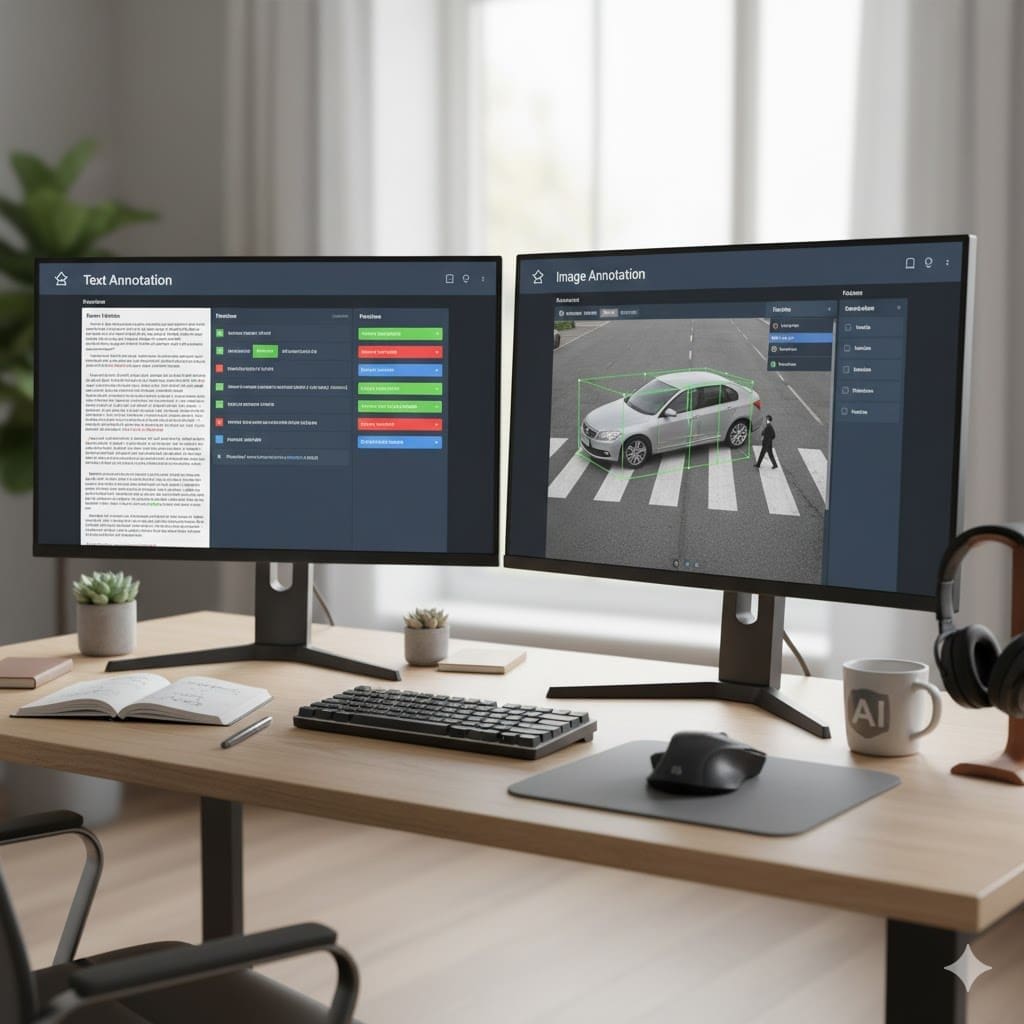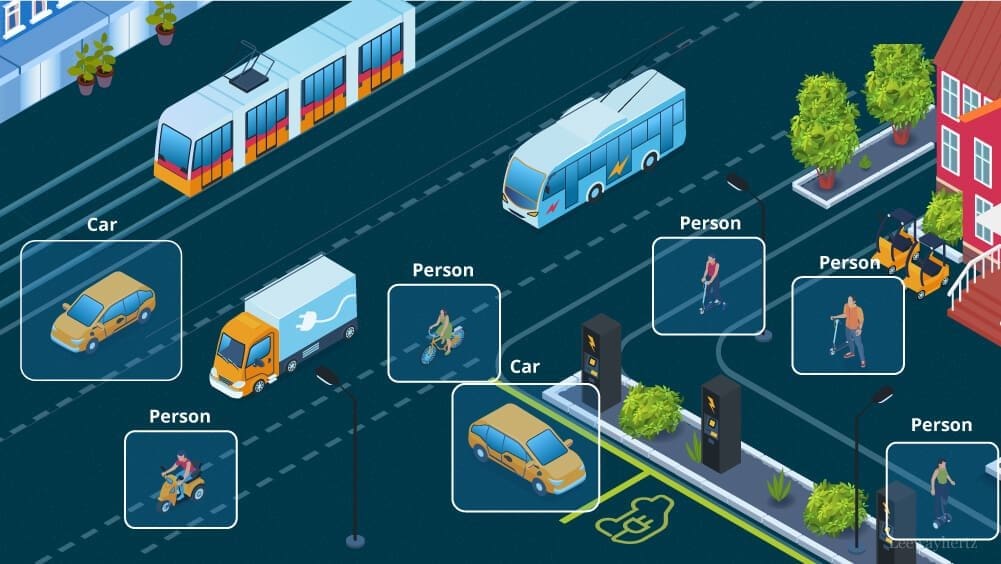The Hidden Gateway to the AI Economy
If you’ve been hunting for a flexible, online-friendly skill that pays, yet doesn’t demand a degree or advanced tech knowledge, data annotation for AI is the opportunity you’ve been waiting for. Most beginners never realize that the apps they use daily, Google Search, ChatGPT, TikTok, Grammarly, and self-driving cars, depend on millions of labeled examples created by human annotators. Right now, demand is exploding. Companies are paying everyday people to help train smarter AI models.
The best part? You can start with zero experience. This guide gives you a complete, step-by-step pathway to start earning from data annotation for AI, even if this is your first online job.
Disclaimer: This article is for informational purposes only. It is not sponsored, endorsed, or affiliated with any tools, platforms, or companies mentioned.
Why Data Annotation for AI Is the Next Big Freelance Opportunity
AI has become the backbone of modern business, but AI cannot learn on its own. Every model requires clean, accurate human-labeled data to function correctly, and companies are desperately seeking individuals who can provide it. This is why data annotation for AI has become one of the fastest-growing entry-level freelance jobs today.
Beginners can start quickly because the work relies more on precision, logic, and consistency than on technical knowledge. If you can follow instructions, analyze examples, and maintain accuracy, you can start earning right away.
The AI Boom and the Silent Workforce Behind It
Behind every AI tool is an invisible workforce labeling images, refining text prompts, reviewing chatbot outputs, and cleaning raw data. This hidden industry is now worth billions and growing faster every year. You don’t need coding or engineering skills; you only need a laptop, stable internet, clear communication, and the patience to complete tasks correctly. Every time you classify text, tag an image, or correct an AI-generated answer, you are teaching the model how to think.
What Data Annotation Actually Is: A Clear Explanation
Before earning money, you must understand exactly what data annotation for AI involves. Think of it as giving AI systems labeled examples so they can learn patterns. In simpler terms, you’re teaching AI how to see, think, understand, and learn so it can operate on its own.
The Role of a Data Annotator is to be the human trainer behind the scenes: reading, labeling, organizing, and evaluating data so the model understands what objects are, what sentiments are expressed, what actions mean, and what constitutes correct or incorrect behavior.
Types of Data You’ll Annotate
You will work with diverse data types.
- Text: correcting grammar, tagging intent, classifying sentiment, improving chatbot responses(e.g., classifying a sentence as a “complaint”).
- Images: drawing boxes around objects, identifying items, and categorizing scenes.
- Audio: transcribing voices, labeling accents, and identifying speakers.
- Video: tracking moving objects frame by frame.
These are simple tasks, but they need practice.

Annotation Tools You’ll Work With Daily
Even beginners quickly learn platforms like Label Studio, Toloka, Remotasks, Appen, Prodigy, or CVAT. Most have drag-and-drop or click-to-tag interfaces with clear instructions, making the learning curve very low.
Skills You Need to Become a High-Earning Data Annotator
You don’t need a degree or special background, but the following skills help you grow faster:
- Attention to Detail: The Skill That Pays the Most
Clients reward accuracy. Even small mistakes can corrupt the data, so detail-oriented beginners perform best. - Consistency, Speed, and the Art of Clean Data Labeling
As you practice, your speed will naturally increase. What matters most is delivering reliable, consistent annotations. - Domain Knowledge: When Specialization Boosts Your Earnings
Fields like medical AI, legal AI, or finance AI pay more. But you can start with general tasks and specialize later. - Soft Skills That Make Clients Come Back
Clear communication, following instructions, and meeting deadlines help you stand out immediately.
How to Become a Data Annotator: A Beginner’s Step-by-Step Path
You don’t need to “figure out” how to start. Here is the practical roadmap beginners actually follow.
1. Understand What Platforms Look For
Most companies want: accuracy, English comprehension, ability to follow complex instructions, and reliability. No experience is required, just proof that you can learn fast.
2. Set Up Your Workspace
A reliable setup is crucial for efficiency:
- Laptop and stable internet.
- Mouse (essential for fast and accurate image/bounding box work).
- Note-taking tool for capturing and organizing complex instructions.
- Quiet space for detailed audio annotation.
3. Build a Portfolio (Even Without Experience)
You can build sample projects by practicing on free platforms:
- Label Studio Community Edition
- CVAT.org
- Roboflow Annotate (free tier)
Export a few sample datasets and descriptions and turn them into a simple PDF portfolio. This proves your capability to potential clients and platforms.
4. Complete Free Training Datasets to Build Skill
Use sites that offer free practice data to sharpen your skills before applying for paid jobs:

The Best Platforms for Data Annotation Jobs (Beginner → Expert)
You should treat your platform choices as a natural progression based on your skill and quality scores. Different platforms serve different levels.
Very Easy Platforms (Low Pay, Good for Absolute Beginners)
These help you learn basic data annotation for AI. These platforms help you build speed and accuracy.
- Remotasks: Easy image labeling, Lidar, basic tasks.
- Clickworker: Simple tagging, categorization, text-based microtasks.
- Yandex Toloka: Consistent training, micro tasks.
Beginner Target: Remotasks → Toloka → Clickworker
Moderate Platforms (Better Pay, Selective)
These platforms require some practice and are the best places to earn a stable income as you grow.
Next Target: Appen → DataForce → OneForma
There are also Amazon Mechanical Turk and Pactera EDGE.
Hard-to-Get, High-Paying Platforms (Top Tier)
These require strong skills, high-quality scores, or passing advanced tests.
- Scale AI: very high pay for quality workers, often focused on AI model evaluation.
- Labelbox Workforce
- Mindrift: Text QA and expert-level annotation.
Ultimate Goal: Scale AI → Labelbox → Mindrift
These offer high hourly rates once you become consistent. There are also others grouped in this category, like Prolific (research annotation tasks), and Invisible Technologies.
What You Really Get Paid in Data Annotation for AI (Honest Breakdown)
The earning potential is strong, but the truth is your first few weeks will feel more like training than earning. Beginners often start small and scale up as they gain accuracy, consistency, and qualifications.
Factors That Determine Whether You Earn $5 or $50 an Hour
| Factor | Impact on Earnings | How to Improve |
| Accuracy | The single biggest factor, low accuracy, means fewer projects. | Study guidelines deeply; follow examples precisely. |
| Speed | The single biggest factor; low accuracy, means fewer projects. | Practice consistently; optimize your workspace. |
| Task Type | Simple tasks (tagging) pay less; QA, RLHF pay more. | Pass qualification tests for complex projects. |
| Specialization | Medical, Legal, or Finance knowledge pays a premium. | Take qualification tests in a niche you understand. |
Reinforcement Learning Human Feedback (RLHF): To explain this in simpler terms, imagine a smart robot gives three different answers to your question. You, the human, choose which answer is the best and the worst, like grading their homework/output. The robot then learns from your choice, so next time it only gives you the best, most helpful answer.
QA: Quality Assurance.
Your pay depends heavily on accuracy, speed, and the platforms you qualify for. Accuracy matters far more than speed in the beginning. Most consistent annotators move from low-paying projects to better ones within one to three months.

Advanced Annotation Skills That Help You Level Up
To transition into the higher-earning tiers, focus on these advanced skills:
1. Quality Assurance (QA) Annotation
Instead of labeling raw data, QA annotators review others’ work and correct mistakes. This role usually pays more because it requires judgment, consistency, and a strong understanding of the guidelines. Many platforms promote their best annotators into QA roles automatically.
2. Mastering Advanced Tools
Learning tools like Label Studio, Prodigy, CVAT, and Labelbox beyond the basics makes you more valuable. Understanding features like nested labels, polygon segmentation, and multi-step workflows accelerates your career.
Turning Data Annotation for AI Into a Real Freelance Income Stream
The biggest turning point is when it stops being a side hustle and becomes a predictable stream of income.
- Develop a Rhythm: Balance speed and accuracy. Study the guidelines, practice slowly, then increase speed.
- Juggling Platforms: Monitor two or three reliable platforms (e.g., Appen, DataForce, OneForma) that regularly post high-quality tasks. When one slows down, the other keeps you earning.
- Transition to Contracts: Eventually, pitch yourself to annotation agencies, AI startups, or research labs. Your portfolio and platform scores serve as proof of capability, leading to higher-paying, long-term contracts.
Future of Data Annotation: Will AI Replace Annotators?
The truth is the opposite. The more powerful AI becomes, the more training data it needs, and the more human oversight is required to correct its mistakes. AI can generate data, but it cannot evaluate subtle meaning, cultural nuance, tone, ethics, or accuracy without human review.
The industry is evolving toward hybrid annotation systems where humans guide AI, refine its outputs, and provide feedback. The demand for skilled human annotators will continue to grow as models become more advanced.

Your 30-Day Beginner Roadmap
Your first month sets the foundation. Focus on a structured approach to build confidence and momentum.
| Week | Focus Area | Key Activity | Goal/Milestone |
| 1 | Understanding | Explore annotation types (Text/Image) and free tools (Label Studio). | Comfort with basic tools and concepts. |
| 2 | Practice | Practice consistently on free datasets (Kaggle/HuggingFace). | Build speed and accuracy on sample data. |
| 3 | Application | Apply to beginner-friendly platforms (Toloka, Remotasks, Clickworker). | Complete first paid microtasks. |
| 4 | Leveling Up | Take qualification tests for intermediate platforms (Appen, DataForce, OneForma). | Secure first stable, higher-paying project. |
Shortcut Method:
Practice on free tools → Build a sample portfolio → Apply to easy platforms → Level up to high-paying platforms.
Data Annotation FAQ
1. Do I need a degree or prior tech experience to start?
No. Data annotation is an entry-level job. You need strong English comprehension, attention to detail, and the ability to follow complex instructions. Your on-the-job accuracy and quality score will replace the need for a degree.
2. How quickly can I start earning a decent income?
Your first few weeks are mostly training, so initial pay is low. With consistent practice and high accuracy scores, most annotators can qualify for moderate-paying tasks (e.g., platforms like Appen or DataForce) and achieve a more stable income stream within 1 to 3 months.
3. What is the most important skill for a data annotator?
Accuracy (or Attention to Detail). Platforms prioritize quality over speed. High accuracy scores are what unlock premium projects and promotions into Quality Assurance roles, which significantly boost your hourly rate.
4. Is the pay hourly or per task?
It is often a mix, but most beginners start with per-task or per-unit payment. High-tier platforms often pay an hourly rate, but only after you have proven your quality and speed, making your effective hourly rate higher than on beginner platforms.
5. What is the best way to practice before applying?
Use free, professional-grade tools like Label Studio (Community Edition) or CVAT to annotate sample data from resources like Kaggle or HuggingFace. This builds a verifiable portfolio and familiarity with the workflow that paid platforms use.
Your Next Step Starts Today
You don’t need a degree, complicated software, or years of training to enter the AI economy. You only need curiosity, consistency, and the willingness to learn.
Start your data annotation for AI journey today by practicing on a free tool, building a small portfolio, and applying to beginner-friendly platforms. In just a few weeks, you will have the confidence and skill to move toward higher-paying work.
Your First Action: Choose one free practice tool (like Label Studio) and annotate one small, free dataset today.




0 Comments